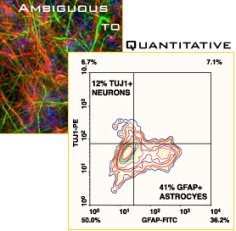
FACS/Phenotyping-A constant challenge working with neural stem and progenitors cells is to determine the percentage of cells of a given phenotype within the culture. Phenotypic characterization of the entire cell population is of the utmost importance in determining the efficacy of your cell culture conditions to generate the neural or glial cell of interest. Immunocytochemistry can get you a long way to understanding the types of cells you obtained in your culture, but it is both time consuming and qualitative in nature.
A far better approach is to analyze your cells by FACS. Although routinely employed within many branches of biology and medical technology, FACS is not a common technique used in Neuroscience. It is our hope that by offering the IntraCtyeTM kits, intracellular FACS analysis will be more accessible to and used more often by neuroscientists. We are currently offering several basic kits as well as a kit designed for rat neural progenitor cell phenotyping (IntraCyte-rNSC). The kit has been tested with our rat Neural Stem Cell Kit and is a powerful analytic tool to analyze the neural and glial cell within your culture.
The IntraCyte kit technology and the precision and accuracy of flow cytometry, enables you to get statistically significant, multi-parameter data at the single-cell level, on thousands of cells per sample in seconds. Even though we enjoy nothing more than looking at beautifully labeled neuronal cultures, we can do without the tedious and inaccurate counting of these cells in the dark!





